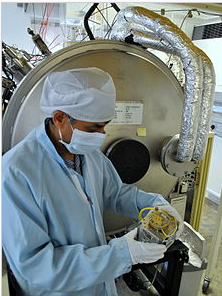
[SatNews] Over the three days, the teams will perform launch and space environment qualification tests on small operational satellites, called “cubesats”...
From May 27 to the 29, the Canadian Space Agency’s David Florida Laboratory (DFL) will host 10 pan-Canadian university teams taking part in the second round of the Canadian Satellite Design Challenge. Over the three days, the teams will perform launch and space environment qualification tests on small operational satellites, called “cubesats” in front of a panel of experts from the industry and Defence Research and Development Canada (DRDC) Ottawa Research Centre. The winning cubesat team will be announced on Thursday, May 29, 2014.
Scientist holding a CubeSat chassis
The Canadian Satellite Design Challenge (CSDC) is a Canada-wide competition for university students to design and build a small operational research satellite. The ultimate goal of this competition is to launch the winning “cubesats” into orbit in order to conduct science research.
The CSDC objectives are to enhance space-related knowledge and capacity at Canadian universities; increase academia-industry co-operation in space-related research and development, and expose participants to the management processes of a large engineering project.
A CubeSat is a type of miniaturized satellite for space research that usually has a volume of exactly one liter (10 cm cube), has a mass of no more than 1.33 kilograms, and typically uses commercial off-the-shelf components for its electronics.
Beginning in 1999, California Polytechnic State University (Cal Poly) and Stanford University developed the CubeSat specifications to help universities worldwide to perform space science and exploration.
While the bulk of development and launches comes from academia, several companies build CubeSats such as large-satellite-maker Boeing, and several small companies. CubeSat projects have even been the subject of Kickstarter campaigns. The CubeSat format is also popular with amateur radio satellite builders.
The CubeSat specification accomplishes several high-level goals. Simplification of the satellite's infrastructure makes it possible to design and produce a workable satellite at low cost. Encapsulation of the launcher–payload interface takes away the prohibitive amount of managerial work that would previously be required for mating a piggyback satellite with its launcher. Unification among payloads and launchers enables quick exchanges of payloads and utilization of launch opportunities on short notice.

